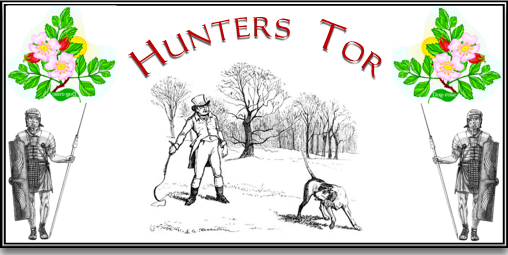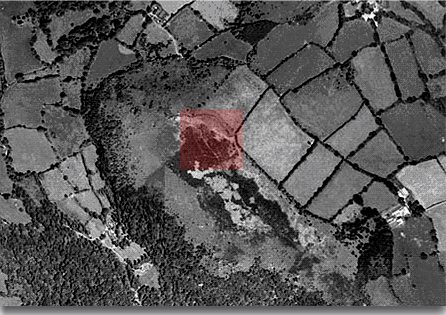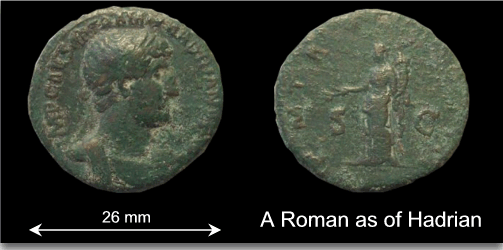
High on the hilltop overlooking Lustleigh Cleave is the granite outcrop known as Hunter’s Tor. To the east of the tor are the remains of an Iron Age hillfort, which as hillforts go would have been in an easily defended location. The fort stands at an impressive 320m with vertigo inducing slopes to the north and west. Originally the hillfort consisted of a triple ramparted enclosure with the two inner banks being stone walled. The third ditch is assumed to have been protected by a bank and ditch. Gerrard, 1997, p.65, comments on how recent fieldwork has revealed that the fort was a two-phased construction, the last stage was constructed over an earlier field-system but for some reason was never completed. As with many ancient monuments the fort has suffered at the hands of the stone wallers with much of its wall linings robbed away to be used in field walls, Fox, 1996, pp. 39 – 40. The plough has also ripped away its fair share of the fort as can be seen from the aerial photo below:

Today the stone lined entrance survives fairly well and its 20m length links the two inner enclosures displaying round terminals at each end. The outer enclosure would have been entered via an 8m wide, south-east facing gap. William Crossing, 1986, p.78, has the following to say about the fort:
“The remains of an ancient camp on this ridge may possibly point to the same period as do those overlooking the gorge of the Teign, and form one in the great chain of forts considered to have been thrown up by the men of the West to check the advance of the invading Roman”.
Now we come to a very unorthodox view in the realms of archaeology and that is on the odd occasion legends can point to hidden archaeological or historical events. This hillfort may well be one such example, it has always been thought that having established themselves at Exeter or Isca, the Romans never ventured too far onto Dartmoor. This seems an amazing fact considering the amount of tin that was to be found on the moor. So, local legend has it that a bloody battle between the local tribes and the Romans once took place at the hillfort. There are even reports that ghosts of the legionaries still haunt the old fort. The National Monuments Register records that a coin from the period of Constantine I (AD 272 – 337) was found a few miles away and Salmon, 1989, p.4, notes that, “Roman coins have been unearthed at Furzleigh Farm”, which is also in the area. It has now been reported (September 2006) that another Roman coin, an as has been found on the ramparts of the hillfort. The PAS finds liaison officer at Exeter museum has dated the coin to one of the Hadrian period (AD76 – 138) and notes that the Emperor Hadrian’s head is shown on the coin wearing a laurel leaf ring on his head. By Hadrian’s time the as was struck in copper and was the lowest value coin in regular issue, the last known example was produced sometime around AD270. Below is an example of an Hadrian as:

It is thought that during the Roman period the coin would have been worth the equivalent of the modern 50p. Today it is possible to buy such a coin for between £8 and £20 depending on its condition.
I know a few coins does not a Legion make and it is quite possible that the ones which have been found could have been the result of some local trading but take the legend in to account there just might be the suggestion of Roman occupation of the old hillfort albeit of a temporary nature?
Bibliography.
Crossing, W. 1986 Gems in a Granite Setting, Devon Books, Exeter.
Fox, A. 1996 Prehistoric Hillforts in Devon, Devon Books, Exeter.
Gerrard, S. 1997 Dartmoor, Batsford, London.
Salmon, J. (Ed.) 1989 Lustleigh Guide, Lustleigh Parish Council, Lustleigh.
 Legendary Dartmoor The many aspects past and present of Dartmoor
Legendary Dartmoor The many aspects past and present of Dartmoor

Great website. We moved within a stones throw of Hunters Tor, I have a permanent view of it from my lounge and bedroom. Heading up there today for the first time. I will let you know if we see any Romans. ” Bloody Romans, what have ever done for us? “
Hi Tim,
I was the person who found the coin many years ago on by coincidence a cold November morning (like today) with a very thin layer of snow. I saw the green object and took it back to Lustleigh to clean and thought it wasRoman. Having contacted the Dartmoor archaeologist I dropped it into Parke and they sent it to Exeter.
About the Legend. I am writing a piece about it. In discussion with Professor Lock of Oxford University today he asked how old is the legend? Do you know, please? Is there any written record of it, please?
Best wishes,
Brian